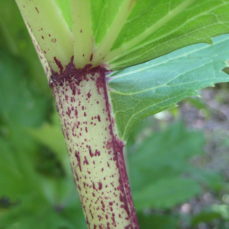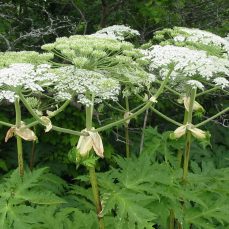
Jan Samanek, Phytosanitary Administration, Bugwood.org

Management Strategy
Squamish
Whistler
Pemberton
Vectors of Spread
Synonyms
Giant cow parsnip
ID Characteristics
General: Giant hogweed is a very tall biennial or short-lived perennial plant that is considered noxious under the BC Weed Control Act. It belongs to the carrot family (Apiaceae).
Flowers: It has numerous groups of small, white flowers arranged in large (20-50cm in diameter), flat-topped, umbrella-like clusters (umbels). Plants only flower after a year or more of growth.
Stem: Tall (2-5 m), with reddish-purple blotches along the stem. Stems are hollow and coated in coarse bristles arising from blister-like pustules.
Leaves: Similar in shape to a maple leaf, but much larger and deeply incised. Giant hogweed leaves can grow up to 3 m long and wide and individual blades can be up to 2.6 cm wide.
Fruits: Are green and oval, about 4 – 10 mm in diameter and 6 – 8 mm wide. They contain dry, brown seeds.
Seeds: Oval-shaped, between 6-10 mm long and have prominent, dark veins.
Roots: Variable – stout, fleshy tuberous root stalks that form perennating buds each year.
Similar Species

Native:
Cow parsnip (Heracleum maximum) is another member of the carrot family; unlike giant hogweed, it is native to the Sea to Sky region. Cow parsnip is smaller (1-2 m) than giant hogweed (5-6 m). You can read more about the differences between the two species in this blog post. The Fraser Valley Invasive Species Society also has a guide to help you tell giant hogweed apart from other plants of the same family.
WARNING: Like giant hogweed, cow parsnip contains a toxic sap that causes severe burns when exposed to sunlight.
Habitat and Origin
Giant hogweed is native to the Caucasus Mountains in southwestern Asia. It was introduced to North America as a garden curiosity due to its size and resemblance to queen anne’s lace. It may have appeared in a garden near French Creek on Vancouver Island in the early 1960s.
Giant hogweed prefers disturbed areas and thrives in wet soil. It is found along streams and rivers, parks, forest edges, on waste ground, near houses, gardens, vacant lots, and along transportation corridors. Giant hogweed is well established in the Metro Vancouver region.
How it Spreads
Giant hogweed reproduces solely by seed and one plant can produce up to 100,000 seeds. Giant hogweed plants generally die after setting seed, but seeds can remain viable for up to 15 years, which leads to the rapid formation of a seed bank.
While about 95% of giant hogweed seeds fall within 9 m of the parent plant, they can also be dispersed short distances by wind. Longer-range dispersal is usually due to water (the seeds can float for up to 8 hours); humans also spread giant hogweed by moving contaminated soil.
Impacts
Clear, toxic sap is found in all parts of giant hogweed. Contact with sap can occur by brushing against the plant, handling plant material, or even by touching tools or mowing equipment that were used for controlling giant hogweed.
Health:
- Hairs on stems and leaves exude a clear, watery sap which contains furanocoumarins and sensitizes skin to U.V. radiations.
- Contact with sunlight after being exposed to sap can result in severe burns, blistering and painful dermatitis (forming 24 to 48 hours after contact).
- Exposure of sap to eyes may also cause temporary or permanent blindness.
Ecological:
- Giant hogweed is a highly competitive plant due to its vigorous early-season growth; ability to coexist with other aggressive growers; and tolerance of shade and seasonal flooding.
- Infestations can result in increased erosion hazards in riparian areas due to characteristically shallow roots.
Stop the Spread
Giant hogweed is found in the Sea to Sky region, but with a limited distribution. The goal is to eradicate this species from the region, and to prevent new introductions.
Learn to identify giant hogweed: use the images presented on this page to learn how to identify giant hogweed
What to do if you spot it: You can report any giant hogweed sightings by visiting our reporting page.
DO:
- Regularly monitor disturbed and undisturbed sites for infestations.
- Ensure soil and gravel is uncontaminated before transport.
- Remove plant material from any equipment used in infested areas and wash before leaving the site.
- Minimize soil disturbance in the area surrounding the infestation.
- Ensure plants (particularly flowering heads or root fragments) are bagged or covered to prevent spread during transport to designated disposal sites (e.g. landfill).
- Take caution when controlling giant hogweed near streams and ditches to prevent the movement of plant parts downstream.
*NOTE: due to its highly toxic properties, it is best to hire a professional to handle giant hogweed infestations to ensure that the necessary precautions are taken.
DO NOT:
- Do not purchase, trade or grow Giant Hogweed.
- Do not move soil that has been contaminated with Giant Hogweed.
- Do not unload, park, or store equipment or vehicles in infested areas.
- Do not compost Giant Hogweed.
Giant Hogweed is found in the Sea to Sky region, but with a limited distribution. The goal is to eradicate this species from the region, and to prevent new introductions.
Learn to identify Giant Hogweed: use the images presented on this page to learn how to identify Giant Hogweed
What to do if you spot it: You can report any Giant Hogweed sightings by visiting our reporting page.
DO:
- Regularly monitor disturbed and undisturbed sites for infestations.
- Ensure soil and gravel is uncontaminated before transport.
- Remove plant material from any equipment used in infested areas and wash before leaving the site.
- Minimize soil disturbance in the area surrounding the infestation.
- Ensure plants (particularly flowering heads or root fragments) are bagged or covered to prevent spread during transport to designated disposal sites (e.g. landfill).
- Take caution when controlling Giant Hogweed near streams and ditches to prevent the movement of plant parts downstream.
**NOTE: due to its highly toxic properties and to ensure that the necessary precautions are taken, it is best to hire a professional to handle Giant Hogweed infestations.
DO NOT:
- Do not purchase, trade or grow Giant Hogweed.
- Do not move soil that has been contaminated with Giant Hogweed.
- Do not unload, park, or store equipment or vehicles in infested areas.
- Do not compost Giant Hogweed.
Control
Mechanical control
- The SSISC Field Crew wear full personal protective equipment (PPE) when treating giant hogweed to protect themselves from the toxic sap.
- Cut all above-ground plant material and place it in a sealed bag for disposal.
- Sever the taproot as low as possible using a sharp, long-handled narrow shovel or spade.
- If possible, cut taproots in early spring (April to May) so that sites can be revisited in early summer (June to July) to target any re-growth or missed plants.
- If it’s not possible to remove the whole plant, removing the flower heads while in flower will provide a short-term, stop-gap solution for preventing seed dispersal, but it does not kill the plant.
Chemical control
- Foliar application of glyphosate, chlorsulfuron + aminocyclopyrachlor, metsulfuron methyl + aminocyclopyrachlor or aminopyralid is most effective in the spring on actively growing plants, followed by a subsequent summer application for late sprouts.
- Where permitted, stem injections of glyphosate are effective after the spring’s heavy sap flow.
- We recommend that any herbicide application be carried out by a person holding a valid BC Pesticide Applicator Certificate. Before selecting and applying herbicides, you must review and follow herbicide labels and application rates; municipal, regional, provincial and federal laws and regulations; species-specific treatment recommendations, and site-specific goals and objectives.
Sea to Sky Distribution
Giant Hogweed Factsheet
Having trouble viewing the factsheet? Don’t worry, all the information is included on this page. You can also contact us with any questions.
Additional Resources
References
- Electronic Atlas of the Flora of British Columbia, Heracleum mantegazzianum
- Fraser Valley Invasive Species Society, Giant Hogweed
- Invasive Species Centre, Giant Hogweed (Heracleum mantegazzianum)
- Invasive Species Council of BC, Giant Hogweed
- Invasive Species Council of BC, Giant Hogweed Factsheet
- Invasive Species Council of Metro Vancouver, Giant Hogweed
- Metro Vancouver and Invasive Species Council of Metro Vancouver, Best Management Practices for Giant Hogweed in the Metro Vancouver Region
- Nature Conservancy of Canada, Giant Hogweed
- Ontario’s Invading Species Awareness Program, Giant Hogweed
- United States Department of Agriculture National Invasive Species Information Center, Giant Hogweed
- Worksafe BC, Toxic Plant Warning: Severe Skin Damage from Giant Hogweed (Heracleum mantegazzianum)





















